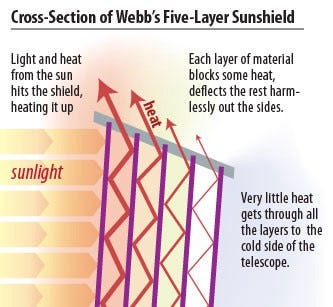How spacecraft are protected in space from extreme temperatures
A look at multi-layer insulation.
Out there in the harsh environment of space, spacecraft must deal with extreme hot and cold temperatures. The spacecraft don’t just need to survive the extreme temperatures but also function in such harsh environments throughout their missions.
Difficulties of managing heat in space
Spacecraft can experience temperatures in space that are either too hot or too cold. Solar radiation can heat the spacecraft to hundreds of degrees, posing a risk to their survival. On the other hand, being eclipsed from the Sun when behind a celestial body (say Earth) can be too cold for the spacecraft, sometime as cold as hundreds of degrees below 0° Celsius.
Experiencing either too hot or too cold temperatures beyond the survival limits of the spacecraft can permanently damage it and its components can cease to function as intended. Depending on the environmental conditions, the spacecraft components need to be heated or cooled down. It is particularly difficult to do so efficiently because:
- Electric power onboard the spacecraft is too limited to make use of heaters excessively.
- The environmental conditions can drastically vary depending on the mission phase, making it difficult for one solution to adapt to all needs.
This is where a technique called multi-layer insulation (MLI) comes in.
Preserving heat using a multi-layer space blanket
Crucial parts of a spacecraft are usually covered with multiple layers of a highly insulating material called Kapton. Between each successive Kapton layer, another insulating material called Mylar is used.

Such multi-layer insulation (MLI) allows minimal heat to pass through either way, thereby maintaining the desired temperature on the spacecraft parts it is designed to protect. Materials used in MLI are also very stable at a wide range of temperatures and do not deform easily. They are thus useful in a wide variety of cases.
#1: Protection against excessive heat
Notably, NASA’s James Webb Space Telescope (JWST) to be launched in 2020 will use a MLI sunshield to protect its optics. The sensitive optics must function at extremely cold temperatures and will get deformed if exposed to excess heat.

Interestingly, the insulating material used between the Kapton layers is no material at all, but vacuum. Vacuum itself is a poor conductor of heat and thus enables the MLI setup to preserve the optics, allowing us to explore the Universe.
#2: Protection against excessive cold
Alternately, missions sent to the outer solar system need to be warm enough to function. At such large distances from the Sun, the spacecraft quickly start losing heat to deep space. A lot of the electronic components can cease functioning at this point or the craft can also be permanently damaged.
NASA’s New Horizons spacecraft on a flyby mission to Pluto was thus fully covered with a gold-colored MLI to retain internal heat.

#3: Why not just use a thick block shield instead?
Using one thick block will conduct heat from one end of the spacecraft to the other. A multi-layer insulation made up of different material means that each layer is hotter/cooler than the other and the heat dissipation is thus minimized. Additionally, a thick shield would increase the weight of the spacecraft which is not desired. MLI on the other hand is quite lightweight.
#4: Protection from impacts
Despite being thin, an MLI covering also provides protection to the spacecraft from micrometeorite impacts. If say, an outer facing layer is damaged, the rest of the layers still serve the purpose because redundant layers are used to enhance reliability.
So that was a sneak peek into a type of thermal protection technology used in space missions.
